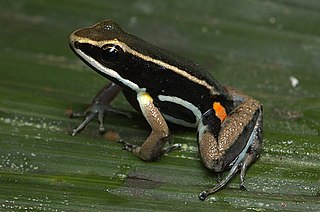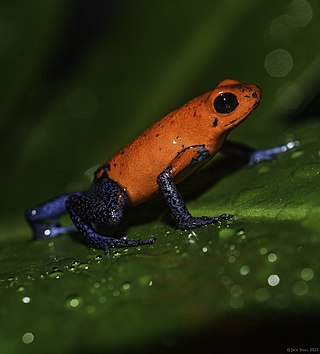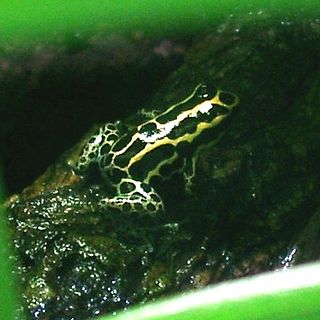
Poison dart frog is the common name of a group of frogs in the family Dendrobatidae which are native to tropical Central and South America. These species are diurnal and often have brightly colored bodies. This bright coloration is correlated with the toxicity of the species, making them aposematic. Some species of the family Dendrobatidae exhibit extremely bright coloration along with high toxicity, while others have cryptic coloration with minimal to no amount of observed toxicity. The species that have great toxicity derive this feature from their diet of ants, mites and termites. However, other species that exhibit cryptic coloration, and low to no amounts of toxicity, eat a much larger variety of prey. Many species of this family are threatened due to human infrastructure encroaching on their habitats.
Colostethus is a genus of poison dart frogs native to Central and South America, from Panama south to Colombia, Ecuador, and northern Peru. Their common name is rocket frogs, but this name may refer to frogs in other genera and families, following the taxonomic revision of the genus in 2006.
The sky-blue poison frog is a species of poison dart frog. It is endemic to Peru and known from the lower eastern versant of the Andes in the upper Amazon basin of the San Martín Region.

Dendrobates is a genus of poison dart frogs native to Central and South America. It once contained numerous species, but most originally placed in this genus have been split off into other genera such as Adelphobates, Ameerega, Andinobates, Epipedobates, Excidobates, Oophaga, Phyllobates and Ranitomeya, leaving only five large to medium-sized species in the genus Dendrobates. All the other genera used to be grouped in with Dendrobates because it was previously thought that all brightly colored poison dart frogs came from the same ancestor but this has since been proven to be incorrect. Dendrobates and Phyllobates evolved conspicuous coloration from the same common ancestor but not the same as any of the other genera listed above.

Epipedobates is a genus of poison dart frogs native to northern South America west of the Andes, including the western slopes. Common name phantasmal poison frogs has been suggested for the genus.

The Aromobatidae are a family of frogs native to Central and South America. They are sometimes referred to as cryptic forest frogs or cryptic poison frogs. They are the sister taxon of the Dendrobatidae, the poison dart frogs, but are not as toxic as most dendrobatids are.

Rheobates palmatus is a species of frog in the family Aromobatidae. It is the type species of genus Rheobates erected in 2006. Its common name is palm rocket frog. It is endemic to Colombia. It is considered to be part of a species complex.

Ameerega bilinguis, the Ecuador poison frog, is a species of frogs in the family Dendrobatidae found in Colombia, Ecuador, and possibly Peru.

Lutz's poison frog is a species of frog in the family Dendrobatidae found in Bolivia and Brazil. Its natural habitats are subtropical or tropical moist lowland forests, subtropical or tropical moist montane forests, moist savanna, subtropical or tropical moist shrubland, rivers, intermittent freshwater marshes, and rocky areas. Reproduction occurs in rocky pools and streams. Eggs are laid under a rock and the male transports tadpoles to wet trenches or small rocky pools. It is threatened by habitat loss.

The Manú poison frog is a frog species in the family Dendrobatidae found in southern Peru and Brazil. It can be found in the drainages of the Manú, Urubamba, Upper Purus and Ucayali Rivers. It can also be found in Serra do Divisor National Park and Alto Juruá Extractive Reserve.

The Peru poison frog, also known as Peruvian poison frog, Peruvian poison-arrow frog and emerald poison frog, is a species of frog in the family Dendrobatidae. It is found in eastern Peru and western Brazil. Its natural habitats are primary premontane and subtropical or tropical moist lowland forests, rivers, freshwater marshes, and intermittent freshwater marshes.
The Oxapampa poison frog is a species of frog in the family Dendrobatidae endemic to Peru near Oxapampa, in the Pasco Region. Its natural habitat is montane tropical rainforest. It is a very rare species threatened by habitat loss.

Oophaga is a genus of poison-dart frogs containing twelve species, many of which were formerly placed in the genus Dendrobates. The frogs are distributed in Central and South America, from Nicaragua south through the Colombian regions of El Chocó and Pacífico to northern Ecuador. Their habitats vary with some species being arboreal while other being terrestrial, but the common feature is that their tadpoles are obligate egg feeders.

Ameerega is a genus of poison dart frogs in the family Dendrobatidae. These frogs live around rocks that are nearby streams. They are found in central South America north to Panama. It contains many former species of the genus Epipedobates.

Silverstoneia is a genus of poison dart frogs from southern Central America and northern South America, between southwestern Costa Rica and southwestern Colombia. It is named in honour of Phillip A. Silverstone, an expert on dendrobatoid frogs.

Hyloxalinae is a subfamily of frogs in the family Dendrobatidae.

Ranitomeya is a genus of dart poison frogs found in Panama and South America south to Peru and Brazil, possibly into Bolivia.

Dendrobatinae is the main subfamily of frogs in the family Dendrobatidae, the poison dart frogs of Central and South America, found from Nicaragua to the Amazon basin in Brazil.

Rheobates is a genus of frogs in the family Aromobatidae. It is endemic to Colombia. These are cryptically coloured frogs with extensive toe webbing. The name Rheobates is derived from the Greek words rheo and βάτης bátēs, in reference to the riparian habitat of the type species Rheobates palmatus. They are associated with streams in sub-Andean forests and foothills of the Andes at low to medium altitudes.

The Leiuperinae are a subfamily of frogs in the family Leptodactylidae. Over 90 species are in five genera. The distribution of this subfamily is from southern Mexico to the Central America and much of South America.
















